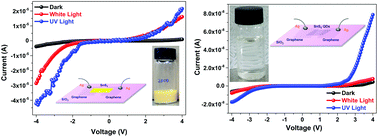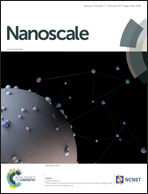Tunable UV-visible absorption of SnS2 layered quantum dots produced by liquid phase exfoliation†
Abstract
4H-SnS2 layered crystals synthesized by a hydrothermal method were used to obtain via liquid phase exfoliation quantum dots (QDs), consisting of a single layer (SLQDs) or multiple layers (MLQDs). Systematic downshift of the peaks in the Raman spectra of crystals with a decrease in size was observed. The bandgap of layered QDs, estimated by UV-visible absorption spectroscopy and the tunneling current measurements using graphene probes, increases from 2.25 eV to 3.50 eV with decreasing size. 2–4 nm SLQDs, which are transparent in the visible region, show selective absorption and photosensitivity at wavelengths in the ultraviolet region of the spectrum while larger MLQDs (5–90 nm) exhibit a broad band absorption in the visible spectral region and the photoresponse under white light. The results show that the layered quantum dots obtained by liquid phase exfoliation exhibit well-controlled and regulated bandgap absorption in a wide tunable wavelength range. These novel layered quantum dots prepared using an inexpensive method of exfoliation and deposition from solution onto various substrates at room temperature can be used to create highly efficient visible-blind ultraviolet photodetectors and multiple bandgap solar cells.



 Please wait while we load your content...
Please wait while we load your content...